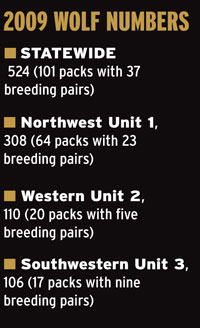At a Kalispell meeting focused on wolves last week, outdoorsmen and ranchers made it clear they want three things: the return of state management, revised wolf population numbers and, in the absence of local control, federal rule changes that better protect livestock in Northwest Montana.
For the first, they stated their case to U.S. House Rep. Dennis Rehberg, who hosted the session at Flathead Valley Community College and has drafted one of several bills aimed at delisting gray wolves in Montana and Idaho.
For the second, they offered their own statistics, in quantities of lost livestock and diminished game sightings during hunting season. Ranchers argue that many livestock kills aren’t confirmed or documented. Hunters say they don’t harvest or see nearly the number of elk and deer as in years past.
Larry Campbell told the 12-person panel that he had killed a bull elk for 14 straight years before his streak ended two years ago.
“I’ve seen more wolves than I’ve seen elk,” he said. “That’s not a good sign.”
And in regards to the rule changes, ranchers said they’re hamstrung in Northwest Montana and other northern areas because of different regulations. While U.S. District Court Judge Donald Molloy’s ruling restored the endangered status for wolves across Montana, the rules governing “experimental, non-essential” populations provide more options for livestock owners to protect their animals.
According to federal and state wildlife agencies, northern wolves re-colonized naturally in Montana from Canada, but experimental populations in the Greater Yellowstone and Central Idaho regions were reintroduced in 1995.
The non-experimental area includes all of the Hi-Line north of the Missouri River from North Dakota to Interstate 15. From there, the boundary follows I-15 down to Butte where it then veers west along Interstate 90.
 |
|
|
Anything south of I-90, except for one little chunk that dips down to Highway 12 around Missoula, is experimental and governed by federal 10(j) rules. That leaves all of Northwest Montana as a non-experimental population, meaning private citizens can’t kill wolves.
Under the 10(j) rules, FWP states that livestock owners and other private citizens “are not allowed to haze or harass wolves or kill wolves seen attacking livestock or domestic dogs,” nor can the state issue kill permits. If a wolf-related livestock loss is confirmed by the U.S. Fish and Wildlife Service (USFWS), state officials can authorize lethal control.
Sen. Bruce Tutvedt, who emceed the FVCC event, said the rules were frustrating for livestock owners.
“Basically, if your wife doesn’t have teeth marks on her, you can’t do anything to the wolf,” Tutvedt said.
But in the southern part of the state, FWP can issue kill permits to private citizens after confirmed livestock losses. Also, “livestock owners, their immediate family members, or their employees can haze or harass wolves or kill wolves seen actively chasing, molesting, or harassing livestock, herding or guarding animals, or domestic dogs on public or private lands.”
Livestock owners in all areas of the state are encouraged to report wolf encounters to FWP or USFWS as quick as possible.
Ed Jonas, a cattle rancher near Rollins, said he lost two heifers last year. His neighbors, he said, have reported wolves chasing their horses and attacking their cat. Jonas was one of 12 panelists invited to speak at the Oct. 6 hearing.
“You don’t sleep well anymore because you never know if you’re going to wake up and have all live animals,” Jonas said.
Jonas also called FWP’s wolf count “inaccurate,” adding, “I believe the scientific methods they use are unsound.” According to FWP, there were 524 wolves statewide in 2009, including 308 in Northwest Montana. Both state and federal officials have acknowledged the counts don’t represent the full wolf populations.
Responding to criticism that the panel was one-sided against wolves, Rehberg said he invited a more diverse group, but some invitees didn’t show. Specifically, Tutvedt said the Sierra Club was invited, and while Defenders of Wildlife participated in a similar event in Dillon, the group didn’t come to Kalispell.
One speaker said, “I thought I was coming to a wolf input session, but it’s more like a witch hunt.” She was one of a handful of wolf advocates.
Aaron Lasco, owner of Spirit Quest Archery, said the past few years have been tough for hunting and he’s worried about the future.
“The face of Montana’s heritage is changing rapidly,” he said.